Radio content can exponentially grow online when it’s visually enhanced. While visuals are great to attract young listeners, they should be additions to audio – not replace it.
It’s the bottom line of a session about visual radio at the first nextrad.io conference in London, which I attended last week. Organized by James Cridland and Matt Deegan, and refreshing! Finally a conference with no panels, no suits, and no DAB (instead, a bit of Radio DNS). Benefits: compact sessions, great variety, many ideas, and nice people!
What is visual radio?
Visual radio is enhancing an audio-only broadcast with visual material to give listeners a richer understanding of the subject matter.
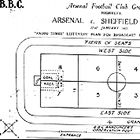
BBC radio sports broadcasts
Visualizing radio is nothing new, only the technology has been improved, says Sam Bailey. He is an Interactive Editor at BBC Music Events. In the old days, the BBC included a map of the soccer field (divided in sectors with each given a number or letter) in their program guide. The reporter would then refer to these squares in his report of the football game. On a side note: this may be the origin of the phrase ‘back to square one’.
Make radio personalities visible
Radio has become a lot more personal, and one of the ways to achieve this was actually visual radio. “In the 1930s, people who listened to their radios had no idea what people on th e other side of the wire sets looked like. It’s human nature that we relate to people better when we know their faces.” That’s the reason why radio stations started to display drawings (and later photos) of their presenters inside magazines and program guides that they published.
Visual radio history bits
- 1950s: The Goon Show, one of the biggest radio comedy shows ever, was recorded on film in the theatre where the actors performed it for the radio
- 1980s: BBC Radio 1 deejays like Steve Wright (now on BBC Radio 2) not only presented on the radio, they also made television appearances
- 1990s: After Chris Evans (now on BBC Radio 2) took his BBC Radio 1 breakfast show to Virgin Radio, it was simulcast on the Sky1 television channel
- 2010s: BBC Radio 1 jock Chris Moyles and Comedy Dave raise £ 2.8 million for Comic Relief in a 52 hour multimedia show (radio, TV, online, social media)
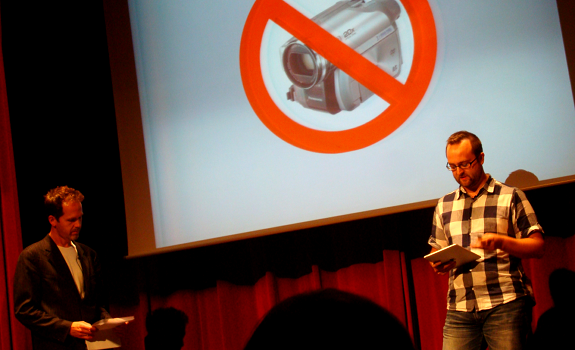
Sam Bailey (standing on the right): “We relate to people better when we know their faces” (photo: Thomas Giger)
Nice results vs. audience magnets
His colleague Joe Harland is Short Form Content Editor at BBC Radio 1. Can visual radio bring in more listeners and advertisers? Based on cases such as:
- Capital FM discjockey Johnny Vaughan gets a few thousand hits for a clip showing a headshave stunt
- BBC Radio 2 morning host Chris Evans is good for 50.000 hits for one of his sporting challenges
he says that “it’s not necessarily changing the game” as it’s “small beer” compared to how many listeners these stations attract. Still, the benefits can be great – especially for shows with smaller audiences.
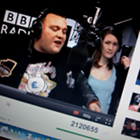 Think outside radio box
Think outside radio box
When rapper K Koke freestyled in Charlie Sloth‘s show on digital Urban station BBC Radio 1Xtra, it was filmed and posted on 1Xtra’s YouTube channel where it generated over 2.000.000 views – for a piece of content heard by 20.000 listeners the first time around. “It’s an increase in awareness; an incentive on top of the screen – click here, go to 1Xtra”, says Joe Harland. “We cannot rely just on our own networks; we’ve got to work outside.”
Radio on the wall
While external (social media) channels are obviously important, the BBC also devotes a lot of attention to its own platforms. The BBC Radio 1 website has undergone a change in look & usability. Sam Bailey explains how the site is designed to meet the habits of young people in the UK today, based on 3 thoughts:
1. How content evolves in social media
The content of Facebook and Twitter is constantly changing. If you make 2 visits to Facebook, 1 hour apart, the main content area looks completely different. “It’s a live service, just like radio.”
2. Where young people consume & buy music
On popular music platforms like iTunes, Amazon and Spotify, “the packshot remains the strong visual identifier for music – in a world where nobody buys physical singles in square boxes.”
3. Which devices young generations use to consume media
The shiny black LCD screen is in teenager’s pockets and laps; on their desks and walls. “If radio isn’t filling that screen, young people are not interested. We anticipated to being on a wall.”
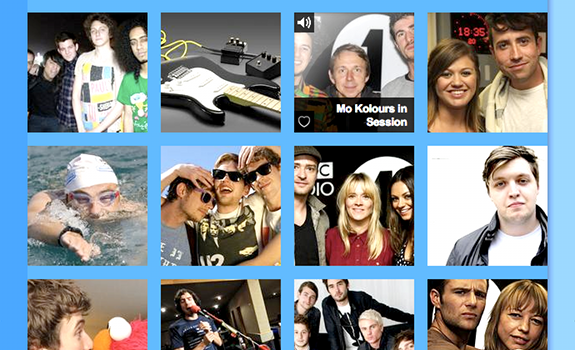
The new BBC Radio 1 site is inspired by social media, music platforms and screen devices (content: BBC Radio 1)
BBC Radio 1 interactive website
Clicking on a track shows the artist biography, its latest clips and albums, and much more. All content appears inside the page through light boxes. It’s a “push-feed” where content is being updated automatically; it doesn’t require the manual browser refresh. People can ‘love’ content and receive recommendations about what they may love, too. Search tools and social media are integrated in the site. I personally think that they’ve done a really nice job in both design and functionality. The only thing that irritates is that most video and audio content is UK-user restricted (rights issues).
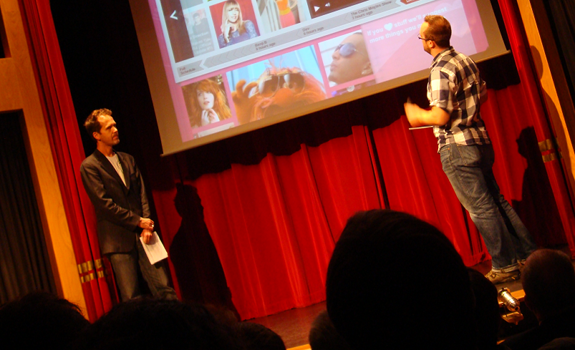
Joe Harland and Sam Bailey show the new BBC Radio 1 website to the nextrad.io audience (photo: Thomas Giger)
Reward new radio audiences
Young people will most likely don’t naturally buy a radio like generations before them. “If you’re lucky, they will buy an app and use it, but listeners got to have an incentive”, Joe Harland says. “It isn’t: we’ve got a beautifully tailored play list which is produced by software and then slightly tweaked by the head of music, and we’ve got someone that somebody once upon a time heard of, to doing links between it.” In his opinion, visual radio could be the way to attract a new generation of media consumers.
 Control your radio content
Control your radio content
“The audience will not switch on the radio to see what’s on, but to decide what else they’ll be doing. And if you don’t visualize your content, they’re going to do it for you.” It seems that time is traffic. If a radio station organized an event but doesn’t put videos on its website soon, someone who’s filmed it has already put it online somewhere else where almost everyone will watch it then. “That’s why visual content is what we have to do, to build new audiences.”
Radio shouldn’t be wallpaper
While some visual content is multi-camera recorded and carefully edited, other movies are filmed with a handy cam and posted online almost directly and 1:1. It seems that we’re not far away from visualizing radio fulltime. If stations have enough capacity to produce visual radio 24/7, should they do it? Sam Bailey thinks not. Visual content should add something to audio – not replace it. “There is something about mystique, picking chosen moments, making visuals glance-able, and not becoming wallpaper.”





Add Your Comment